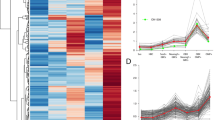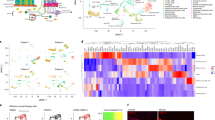Abstract
We demonstrate that members of the olfactory receptor (OR) gene family are distributed on all but a few human chromosomes. Through FISH analysis, we show that OR sequences reside at more than 25 locations in the human genome. Their distribution is biased for terminal bands. Flow-sorted chromosomes were used to isolate 87 OR sequences derived from 16 chromosomes. Their sequence-relationships are indicative of the inter- and intrachromosomal duplications responsible for OR family expansion. The human genome has accumulated a striking number of dysfunctional copies: 72% of the sequences are pseudogenes. ORF-containing sequences predominate on chromosomes 7,16 and 17.
This is a preview of subscription content, access via your institution
Access options
Subscribe to this journal
Receive 12 print issues and online access
$209.00 per year
only $17.42 per issue
Buy this article
- Purchase on Springer Link
- Instant access to full article PDF
Prices may be subject to local taxes which are calculated during checkout
Similar content being viewed by others
References
Buck, L. & Axel, R. A novel multigene family may encode odorant receptors: a molecular basis for odour recognition. Cell 65, 175–187 (1991).
Parmentier, M. et al. Expression of members of the putative olfactory receptor gene family in mammalian germ cells. Nature 355, 453–455 (1992).
Selbie, L.A., Townsend-Nicholson, A., lismaa, T.I. & Shine, J. Novel G protein-coupled receptors: a gene family of putative human olfactory receptor sequences. Mol. Brain Res. 13, 159–163 (1992).
Schurmans, S. et al. The OLFR1 gene encoding the HGMP07E putative olfactory receptor maps to the 17p13-p12 region of the human genome and reveals an MSPL restriction fragment length polymorphism. Cytogenet. Cell Genet. 6, 200–204 (1993).
Ben-Arie, N. et al. Olfactory receptor gene cluster on human chromosome 17: possible duplication of an ancestral receptor repertoire. Hum. Mol. Genet. 3, 229–235 (1994).
Ressler, K.J., Sullivan, S.L. & Buck, L.B. A zonal organization of odorant receptor gene expression in the olfactory epithelium. Cell 73, 597–609 (1993).
Ngai, J., Dowling, M.M., Buck, L., Axel, R. & Chess, A. The family of genes encoding odorant receptors in the channel catfish. Cell 72, 657–666 (1993).
Freitag, J., Krieger, J., Strotman, J. & Breer, H. Two classes of olfactory receptors in Xenopus laevis. Neuron 15, 1383–1392 (1995).
Ressler, K.J., Sullivan, S.L. & Buck, L.B. A molecular dissection of spatial patterning in the olfactory system. Curr. Opin. Neur. 4, 588–596 (1994).
Glusman, G., Clifton, S., Roe, B. & Lancet, D. Sequence analysis in the olfactory receptor gene cluster on human chromosome 17: recombinatorial events affecting receptor diversity. Genomics 37, 147–160 (1996).
Brandriff, B.B. et al. Human Chromosome 19p: a Fluorescence In Situ Hybridization map with genomic distance estimate for 79 intervals spanning 20 Mb. Genomics 23, 582–591 (1994).
Trask, B. et al. Fluorescence in situ hybridization mapping of human chromosome 19: cytogenetic band location of 540 cosmids and 70 genes or DNA markers. Genomics 15, 133–145 (1993).
Fan, W.F., Liu, Y.C., Parimoo, S. & Weissman, S.M. Olfactory receptor-like genes are located in the human major histocompatibility complex. Genomics 27, 119–123 (1995).
Gruen, J.R. et al. A transcription map of the major histocompatibility complex (MHC) Class I region. Genomics 36, 70–85 (1996).
Sullivan, S.L., Adamson, M.C., Ressler, K.J., Kozak, C.A. & Buck, L.B. The chromosomal distribution of mouse odorant receptor genes. Proc. Natl. Acad. Sci. USA 93, 884–888 (1996).
Korenberg, J.R., Chen, X.-N., Adams, M.D. & Venter, C. Toward a cDNA map of the human genome. Genomics 29, 364–370 (1995).
Telenius, H. et al. Degenerate oligonucleotide-primed PCR: general amplification of target DNA by a single degenerate primer. Genomics 13, 718–725 (1992).
Telenius, H. et al. Cytogenetic analysis by chromosome painting using DOP-PCR amplified flow-soretd chromosomes. Genes, Chromosomes & Cancer 4, 257–263 (1992).
Lancet, D. & Ben-Arie, N. Olfactory receptors. Curr. Biol. 3, 668–674 (1993).
Trask, B. et al. Members of the olfactory receptor gene family are contained in large blocks of DNA duplicated polymorphically near the ends of human chromosomes. Hum. Mol. Genet. (1998).
Eichler, E.E. et al. Interchromosomal duplications of the adrenoleukodystrophy locus: a phenomenon of pericentromeric plasticity. Hum. Mol. Genet. 6, 991–1002 (1997).
Craig, J. & Bickmore, W.A. The distribution of CpG islands in mammalian chromosomes. Nature Genet. 7, 376–382 (1994).
Saccone, S., De Sario, A., Delia Valle, G. & Bernardi, G. The highest gene concentration in the human genome are in telomeric bands of metaphase chromosomes. Proc. Natl. Acad. Sci. USA 89, 4913–4917 (1992).
Lundin, L.G. Evolution of the vertebrates genome as reflected in paralogous chromosomal regions in man and the house mouse. Genomics 16, 1–19 (1993).
Ohno, S., Wolf, U. & Atkin, N.B. Evolution from fish to mammals by gene duplication. Hereditas 59, 169–187 (1968).
van Rhee, A.M., Fischer, B. & Jacobson, K.A. Modelling the P2Y purinoceptor using rhodopsin as template. Drug Des. Discov. 13, 133–154 (1995).
Rosenthal, W., Antaramian, A., Gilbert, S. & Birnbaumer, M. Nephrogenic diabetes insipidus. J. Biol. Chem. 268, 13030–13033 (1993).
Marchese, A. et al. Cloning of human genes encoding novel G protein-coupled receptors. Genomics 23, 609–618 (1994).
Ohno, S. Evolution by Gene Duplication. (Springer Verlag, Berlin/Heidelberg/New York, 1970).
Trask, B.J. et al. Characterization of somatic cell hybrids by bivariate flow karyotyping by in situ hybridization. Somat. Cell Mol. Genet. 17, 117–136 (1991).
Mefford, H., van den Engh, G.J., Friedman, C. & Trask, B.J. Analysis of the variation in chromosome size among diverse human population by bivariate flow karyotyping. Hum. Genet. 100, 138–144 (1997).
Rouquier, S. et al. Direct selection of cDNAs using whole chromosomes. Nucleic Acids Res. 23, 4415–4420 (1995).
Goold, R.D. et al. The development of sequence-tagged sites for human chromosome 4. Hum. Mol. Genet. 2, 1271–1288 (1993).
Lemieux, N., Dutrillaux, B. & Viegas-Péquignot, E. A simple method for simultaneous R- or G-banding and fluorescence in situ hybridization of small single-copy genes. Cytogenet. Cell Genet. 59, 311–312 (1992).
Probst, W.C., Snyder, L.A., Schuster, D.I., Brosius, J. & Sealfon, S.C. Sequence alignment of the G-protein coupled receptor superfamily. DNA Cell Biol. 11, 1–20 (1992).
Author information
Authors and Affiliations
Corresponding author
Rights and permissions
About this article
Cite this article
Rouquier, S., Taviaux, S., Trask, B. et al. Distribution of olfactory receptor genes in the human genome. Nat Genet 18, 243–250 (1998). https://doi.org/10.1038/ng0398-243
Received:
Accepted:
Issue Date:
DOI: https://doi.org/10.1038/ng0398-243
This article is cited by
-
Comparative Evaluation of Sensitivity to Hexanal Between Human and Canine Olfactory Receptors
Biotechnology and Bioprocess Engineering (2019)
-
SIRT1-dependent modulation of methylation and acetylation of histone H3 on lysine 9 (H3K9) in the zygotic pronuclei improves porcine embryo development
Journal of Animal Science and Biotechnology (2017)
-
Genetic variants affecting equivalent protein family positions reflect human diversity
Scientific Reports (2017)
-
Analysis of cattle olfactory subgenome: the first detail study on the characteristics of the complete olfactory receptor repertoire of a ruminant
BMC Genomics (2013)
-
The complete swine olfactory subgenome: expansion of the olfactory gene repertoire in the pig genome
BMC Genomics (2012)



